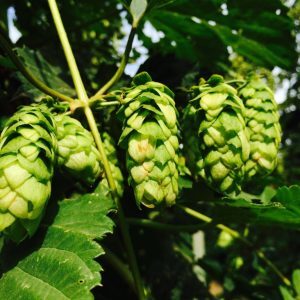
For many, hops are the most exciting ingredient in beer. When talking to anyone about hops the first thing you will probably hear as the fun fact of the day, they’re closely related to marijuana. Don’t get too excited though, hops contain no THC.
Hops provide a lot of the aromatic character and majority of the bittering character within beer. Traditional hop varieties were quite low in Alpha acids and require a larger quantity for to reach a higher level of bitterness. Today there are many new varieties of hops grown in regions all around the world which people have come to know and love. They’re higher in alpha acids and have incredibly punchy aromas of citrus, berries, pine, and stone fruits. Alpha acids are found in three different types and depending on the hop variety will depend on what exact acid compound is found. The compounds are Humulone, Adhumulone and Cohumulone. Hops with a higher concentration of Cohumulone tend to have a harsher bitterness factor than those with a lower concentration.
In Australia most of the hops you purchase will come pelletised but you can sometimes find them whole. We sell a wide range of pellet hops from all around the world to suit the style of beer you'd like to create. They come vacuum packed in foil bags and stored refrigerated so you can receive them as fresh as possible. Pellet hops typically have a better shelf life than whole hops and are better utilised during brewing due to the larger surface area.
Hops are usually added during one of four stages of the brewing process depending on the desired hop character. The start of the boil, know as a 'bittering' addition, during the middle of the boil, known as a 'flavour' addition, at the end of the boil, known as a 'flame out' addition and during the fermentation, know as a 'dry hop'.
- Bittering, as the name suggests this addition adds bitterness to the final beer and very little aroma. When the hops are above about 80C, the alpha acids will isomerise and create a bitter character. The level of alpha acids and the duration of the boil will determine the bitterness and can be calculated using brewing software. As this addition is usually boiled for an hour or more the volatile aromatic compounds in the hops are boiled off.
- Flavour, this addition is made during the boil at different times and will add both bitterness and aroma depending on how long they are boiled. This was thought to add flavour to the beer but many modern brewers are moving away from this addition and just adding hops at the start and end of the boil.
- Flame out, this is a hop addition at the very end of the boil when you turn off your elements or burner. Commercial brewers will often call this a 'whirlpool' addition as they add the hops and transfer to another vessel to create a whirlpool and drop the solids from the hot wort. The hot temperature of the wort will help to extract the oils from the hops but as it isn't hot for a very long period not all the alpha acids will be isomerised.
- Dry hop, is where hops are added to the fermenter during or at the end of fermentation. This addition will add an aromatic character and very little bittering to the beer. As the wort is much cooler than in the boil the hops need to be left in contact for several days for good extraction. Dry hopping adds the wonderful pine, citrus, floral, earthy aromas that we love in pale ales and IPA's. Excessive rates of dry hopping can sometimes lead to undesirable grassy flavours though. You do need to be careful adding anything after the boil as you can risk infecting your beer but hop pellets are generally considered safe to add straight to the fermenter as they have antimicrobial properties.
The last way hops are used, and this isn’t overly common, is in the mash. Breweries have experimented with hops in the mash, however this is not a step that is employed by many.
If you're brewing with fresh wort kits or extract kits adding some dry hop to your fermenter or keg is a great way to change up the favour and add some extra character.
One issue with adding hops is that they can block up your valves, chillers, pump, disconnects etc, we sell a variety of options to help reduce this. During the boil you can either use a hop spider which is a stainless mesh basket to hang over the side of the kettle. You can also fit a bazooka screen to the inlet of the valve. When adding hops into a keg the stainless hop bombs are a great way to add small amounts and the hop tube is ideal for larger additions. Just make sure you sanitise the hop tube/bomb before adding the pellets.
We now sell The Hops List book which lists most of the hops available with a description and typical alpha acids. A great way to discover new hops or substitutions if you can't find the one you're after.
